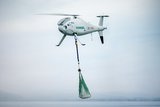Saab to deliver UAV to Swedish Police
The Swedish Police has awarded a contract to Saab for the delivery of three UAV systems, it was announced on 13 January.
The system selected is based around AeroVironment’s Qube quadcopter aircraft. The UAS will be fitted with day/night sensors and cameras, and will be delivered as part of a system incorporating ground station, spare parts, consumables, documentation, training and technical support.
The Swedish Police will trial the system in operations during 2016.
Deliveries will take place in 2016 and the contract will be in effect from 2016 to 2018.
Jonas Hjelm, head, Saab’s business area support and services, said: ‘This move to provide unmanned systems to support government services gives us a good foundation to evolve this technology further. The contract also strengthens our support and maintenance services for civil security applications.’
More from Uncrewed Vehicles
-
Jammer resistant drone designs spark search for countermeasures
The Russia-Ukraine conflict has driven another stage of evolution for drones and the counter measures to defend against them.
-
![L3Harris launches Amorphous software for control of uncrewed platforms]()
L3Harris launches Amorphous software for control of uncrewed platforms
The new Amorphous software is a universal controller that would allow a single operator to control a swarm of “thousands” of uncrewed systems, from drones to underwater platforms.
-
ideaForge unveils new UAVs at Aero India 2025
India UAV supplier ideaForge has launched the Netra 5 and Switch V2 drones at Aero India 2025, boasting of enhanced endurance, AI-driven autonomy and improved operational capabilities.
-
![Shaping the future of defence: What 2025 holds for the global drone market]()
Shaping the future of defence: What 2025 holds for the global drone market
The UAV market is experiencing unprecedented growth, with innovations in technology and battlefield applications driving demand across military sectors. From the battlefields of Ukraine to NATO exercises and beyond, drones are transforming how wars are fought and supported.
-
![Maris-Tech confirms customers signing up for Jupiter Drones codec and AI-powered system]()
Maris-Tech confirms customers signing up for Jupiter Drones codec and AI-powered system
Launched at AUSA in October, the company’s multi-stream video codec is attempting to bring a new lease of life to drone technology through its AI accelerator.
-
![AUSA 2024: Quantum-Systems targets big 2025 with UAS developments]()
AUSA 2024: Quantum-Systems targets big 2025 with UAS developments
Quantum-Systems has been upgrading its UAS family, with new versions of the Vector, Reliant and Twister drones set for release throughout 2025.
























